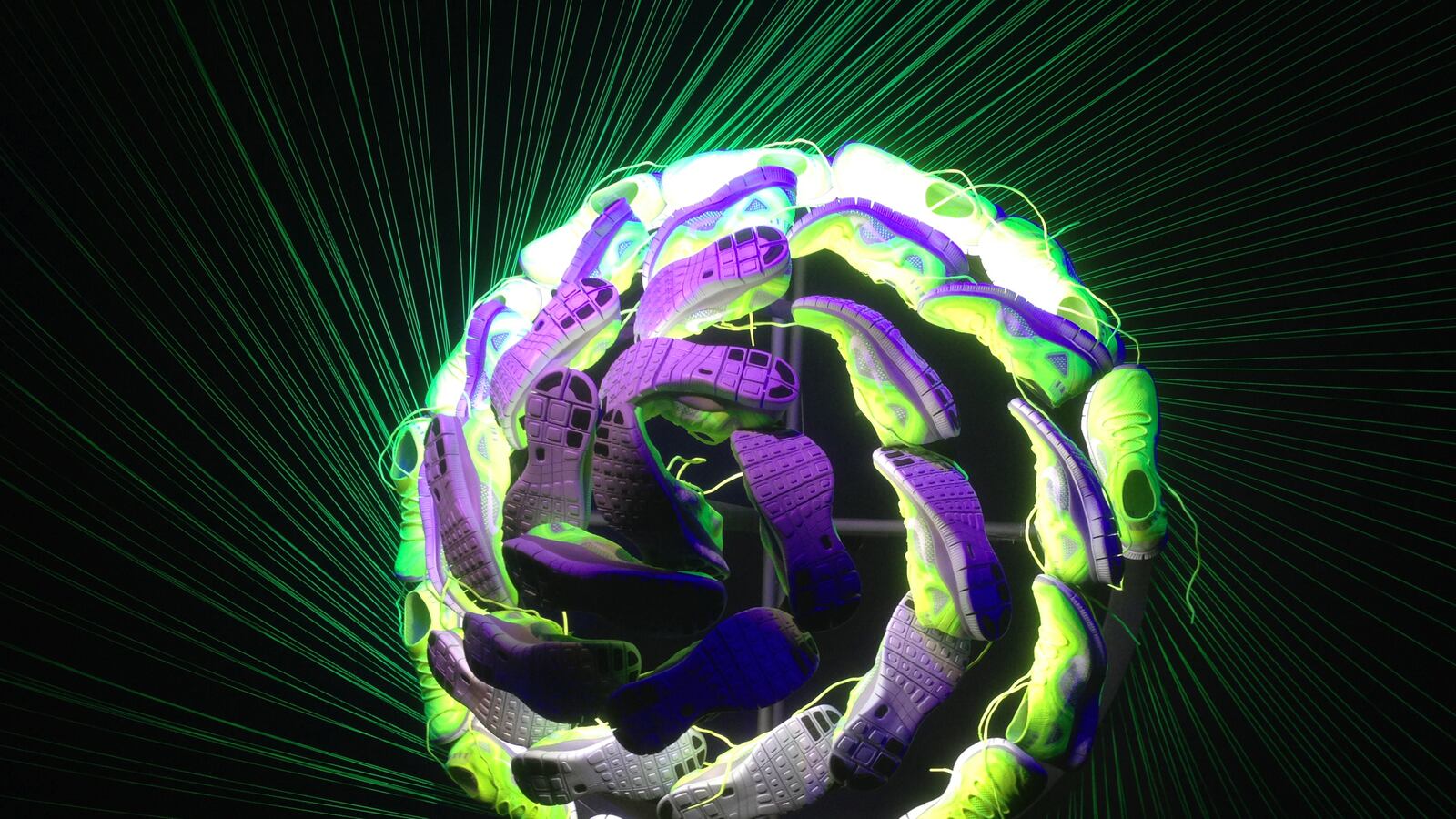When I got the email invite to Tuesday’s top-secret global summit at the world headquarters of Nike Corp., I gotta admit, a little part of me felt like I’d just opened a Wonka Bar and found a golden ticket inside.

Not necessarily because I thought a trip to the bowels of the Swoosh would be anywhere near as cool as visiting the Chocolate Factory and sucking on gobstoppers that last forever, but because I live in nearby Eugene, aka “Track Town USA,” where the sinewy and mustachioed Steve Prefontaine became a folk hero; where he and legendary University of Oregon coach Bill Bowerman and alum Phil Knight basically turned the grunting and panting once known as “jogging” into the sleek, stylish, international obsession with “running” it is today. In Eugene, wearing Nikes passes for business attire. “Pre’s rock,” where the track star died in a car crash, is a sacred shrine. The Nike store in Eugene is a tourist attraction. If you don’t run here, there’s something wrong with you.
In Eugene, we call Knight Uncle Phil. We call him that because he bankrolls these incredible structures on the campus of his alma mater, the University of Oregon: buildings like the $41 million Jaqua Center, which as a measure of its $805 cost per square foot is more expensive than the Cosmopolitan Hotel in Vegas. (The Jaqua Center is a study hall for student-athletes.) We joke all the time about the flashy uniforms Uncle Phil buys for the football team, the pimped-out athletic facility he built for athletes to pump iron. (That crazy expensive study hall is also known derisively as the “glass box for dumb jocks.”) Same kind of stuff you elitist haters of fun complain about at Alabama or Ohio State, I know, but in Eugene, the personification of either the heroism or depravity that is college football and money and sports all tends to lead back to this one guy, Uncle Phil, and his one company, Nike.
So whether you’re a Just Do It fanboy or you secretly hope the company will be bought out by Birkenstock and shuttered, there’s no denying the omnipresence of the Nike brand in a town like Eugene and a state like Oregon. No denying a certain mystique about the man behind the curtain at headquarters in Beaverton. Are there chocolate rivers? Oompa Loompas? Would we get to see Uncle Phil himself accepting or rejecting one sneaker design after the next? Are fat people allowed to work there? I had to find out.

I arrived at 1 Bowerman Drive on Tuesday morning along with literally busloads of other “media,” scooped up from the swanky Portland hotel Nike booked for those outlets less concerned about “media ethics” than others. Of 80 or 90 journalists who filtered into the Tiger Woods Center on the company’s sprawling campus in the Portland suburb of Beaverton for the “Nike Nature Amplified” keynote speech, less than a quarter were U.S.-based. Some wore translation headsets kinked around their ears. They typed and tweeted and photographed the big blue screen with the swoosh symbols amid a Daft Punk soundtrack, until CEO Mark Parker took the stage.
Parker was no Wonka. Not only did he begin by referring to the legendary track coach who co-founded the company as Bill Bowden (he corrected himself immediately), Parker’s presentation seemed to treat the idea that running on concrete and asphalt surfaces was some kind of new phenomenon that the company had only just discovered and wanted to share with all of us now. In the old days, we ran around barefoot, he explained, but now we run in concrete jungles—and his company’s focus is directed squarely at how to account for that while still making shoes and apparel that “work invisibly with the human body.”
Hard to disagree with that approach, of course, but it all just felt kind of dated. Haven’t we been running around on concrete for decades now? Wasn’t it Nike, in fact, that kicked off this whole trend of crazily thick padding in the soles of runners’s shoes to begin with, convincing us that we needed that support, that those flat-bottomed Chuck Taylors were killing us? Isn’t the whole barefoot running craze that has swept the nation in recent years a backlash against this long-prevailing conventional wisdom?
Is Nike backpedaling, in other words? That’s what I was wondering as I watched presenter after presenter emphasize the day’s theme and the company’s clear focus: “Nature Amplified,” which is really just a buzzy way to say “minimalist.” By “Nature Amplified,” several executives told journalists over the next two hours, we mean starting with the foot, the body; understanding the most effective and natural way humans run or jump or throw; and then trying to build shoes and apparel that offer only the necessary amount of support and stability to “amplify” those efforts without getting in the way.
Was this an admittance that the old approach was the wrong one, then? The whole premise of the barefoot running philosophy is that these overcushioned shoes have atrophied the muscles in our feet and calves and quads so much that we’re sort of addicted to them now, and we’d be stronger and faster and less injury-prone if we retrained our gait and stride to land on the balls of our feet, instead of the heels. Was the world’s largest shoe company finally hopping on this bandwagon?
I tried several times to find polite ways to ask this question of several Nike executives Tuesday, and they all gave varying but interesting answers. One pointed out that some people need the kind of support built into some of the company’s more thickly padded soles. Another noted that Nike put out its version of a shoe that attempts to mimic the natural human gait nearly 10 years ago, with the release of the Nike Free. Two others talked of “pendulums,” of the idea that several decades ago, the pendulum had swung wildly toward the “more supportive” side of the equation and perhaps now has swung back the other way (as if companies like Nike, trying to convince people to buy new shoes, had nothing to do with that). Vice president of footwear Tony Bignell was the first to admit that Nike (and others) had in the past perhaps gone too far.
“Maybe we added too much,” he told The Daily Beast, “and the pendulum swung back.”
There was also some between-the-lines bristling at these scrappy upstarts like Vibram FiveFingers, who’ve convinced millions of runners that they need to “strip down their product (to nearly nothing) and calling it ‘barefoot,’” as Parker put it. That, the company seems firmly convinced, is the pendulum swinging too far in the other direction.

“If you go too minimal, it’s not practical, for a lot of reasons,” Brian Stewart, vice president of footwear innovation, told me. “But I do feel like the barefoot thing debunked a lot of super-intervention,” of the more extreme additions of support and stability to sneakers of all stripes.
Stewart said he and his colleagues talk “a lot” about how minimal is too minimal, but at this point, he and Nike remain convinced that some cushioning is necessary in nearly all circumstances, and the key is finding exactly the right amount—“the perfect balance,” as Bignell put it, between the minimalistic feel of barefoot running and the necessary protection we need.
The "next big thing" unveiled Tuesday reinvented no wheels—the star product was a hybrid shoe that pairs Nike’s flexible Free sole with its Flyknit fabric on the upper of the shoe, a fabric that feels much like a snug-fitting sock. The $160 Nike Free Flyknit, available August 1, is the result, which Parker described as “like a second skin.”
We all got a chance to try the new kicks on, even to stomp around the soccer field in them, so I can confirm they seem evolutionary, if not necessarily revolutionary. But maybe I was just grumpy at the lack of furniture built out of candy at 1 Bowerman Drive.
There were a few behind-the-curtain-y moments, to be sure. Athletes and engineers happily demonstrated the superfast cameras with which every nanosecond of every twist in, say, a slam dunk, can be recorded and analyzed; the sweating, walking robot named HAL that helps the company design clothing that perfectly regulates heat and moisture. And I volunteered for a 3-D model of my own feet, proving that they are embarrassingly uneven in length, arch height, width, and just about everything else. But most of it felt more like a museum than a laboratory. The one time I did slink over to the window that looked into a room where the company’s scientists are actually designing next-gen prototypes, the lights suddenly went out.
Coincidence? Unlikely. But I didn’t really expect to get the secret formula anyway. In the $20 billion running industry, Uncle Phil would be as crazy as Willy Wonka to let a snooping journo like me get a look at anything really magical.






